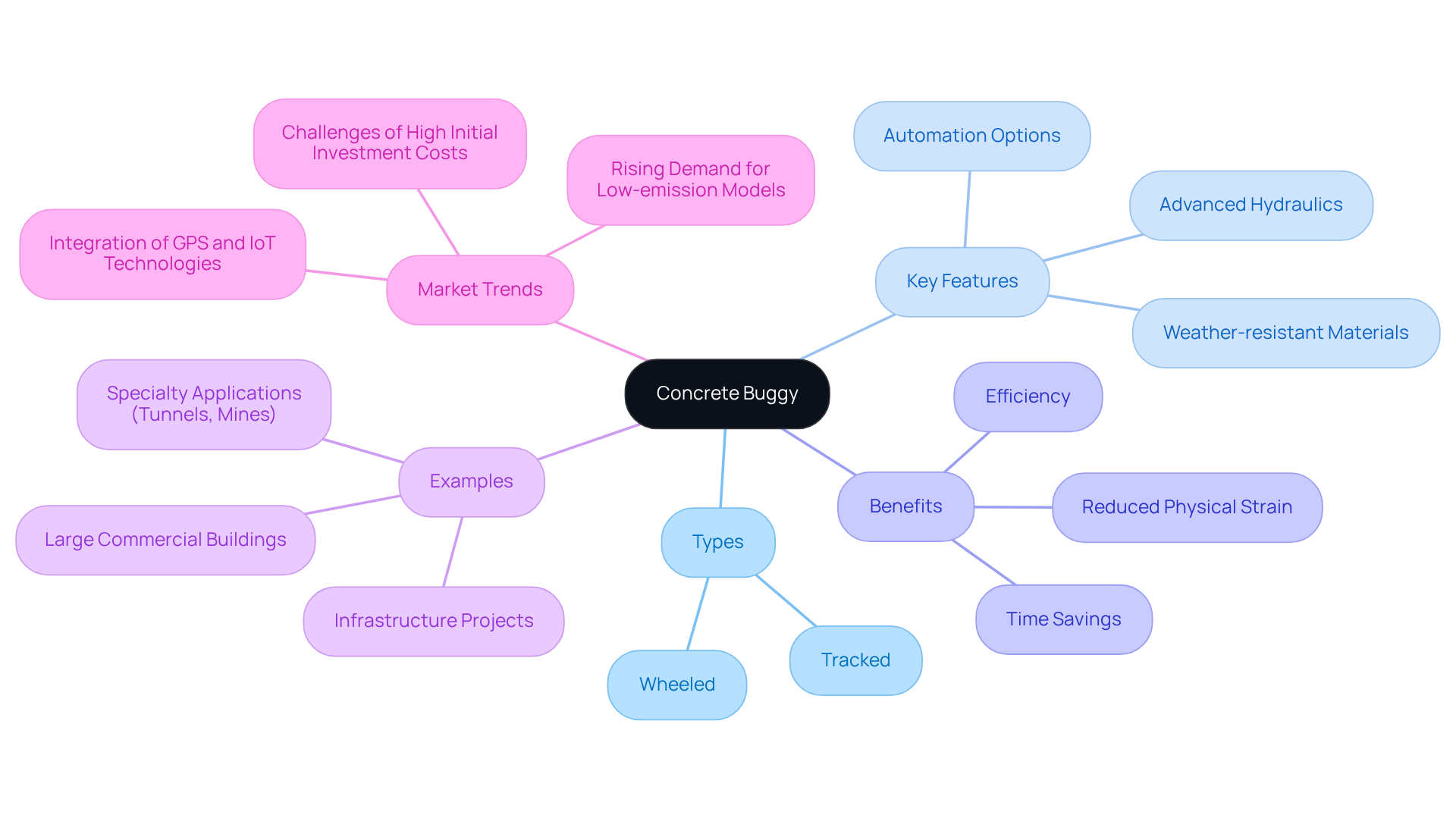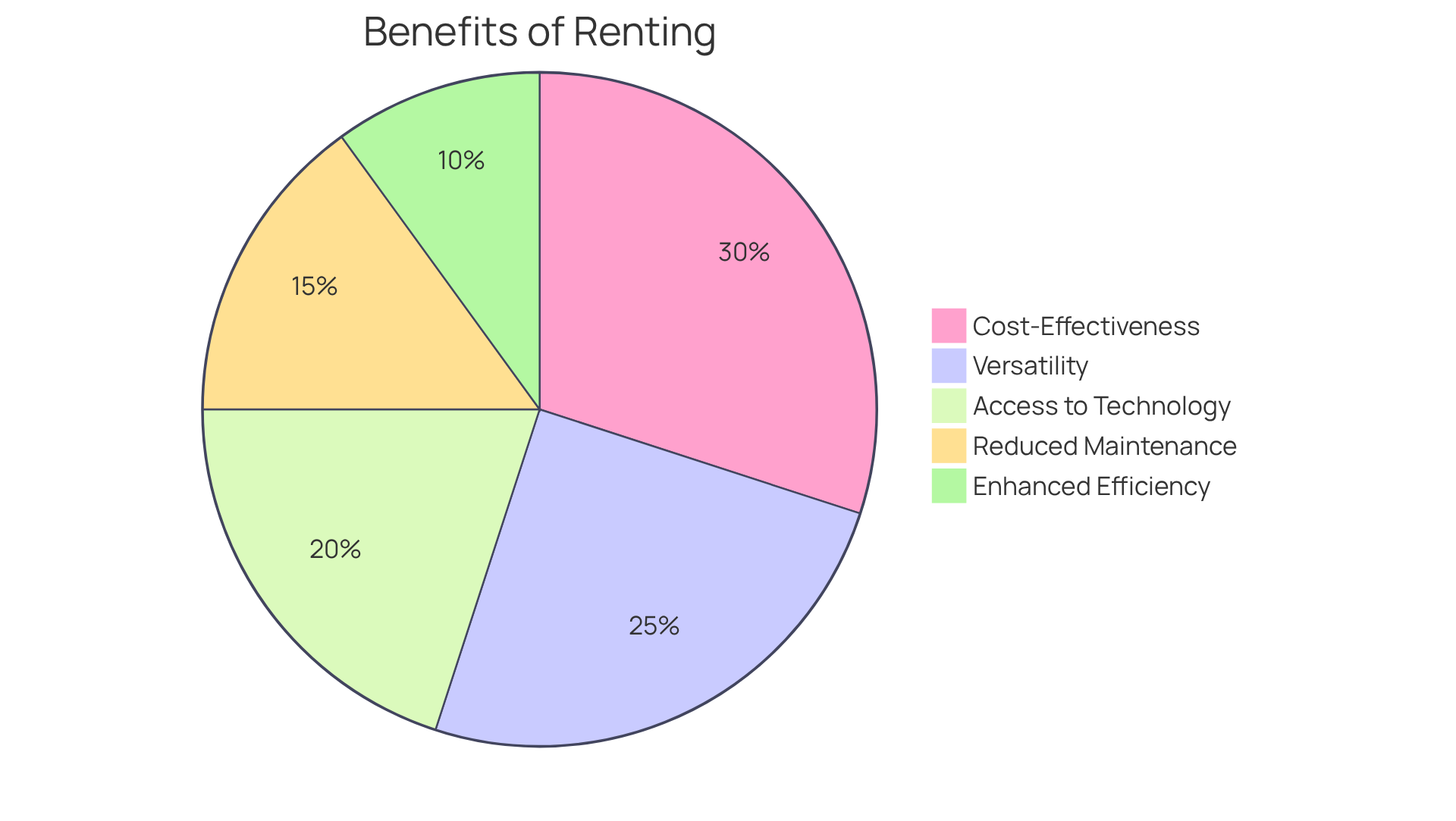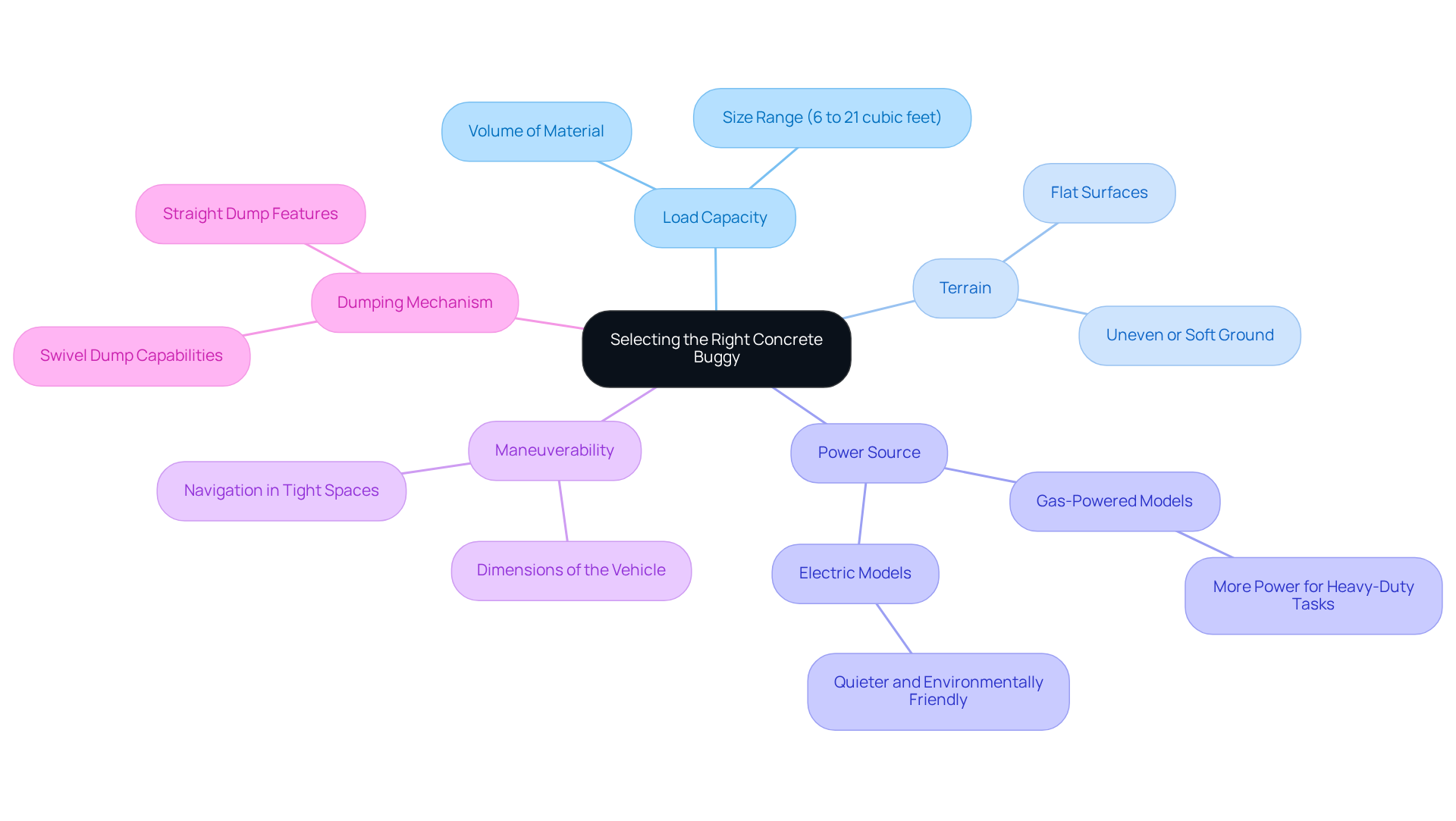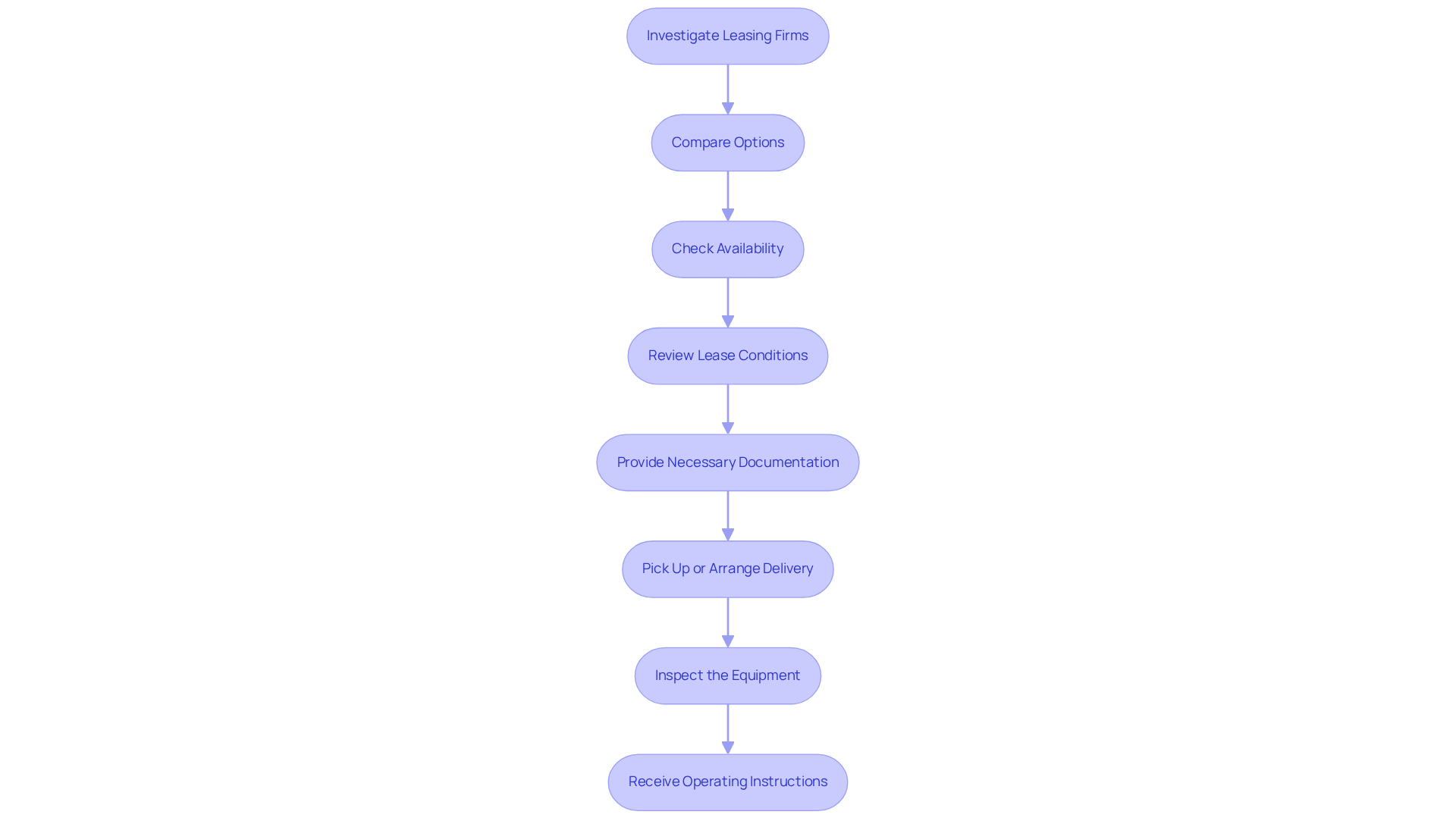Overview
Renting a concrete buggy for your construction project offers significant advantages, including cost-effectiveness, flexibility, and access to advanced technology. These benefits not only enhance efficiency but also reduce labor strain, making it a wise choice for any construction endeavor. This article outlines a comprehensive process for renting, detailing key considerations such as:
- Load capacity
- Terrain suitability
By focusing on these aspects, users can select the right equipment tailored to their specific project needs, ensuring optimal performance and reliability.
Key Highlights:
- Concrete buggies, or power carts, are essential for efficiently transporting and pouring concrete at construction sites.
- Available in wheeled and tracked configurations, concrete buggies have load capacities ranging from 1,000 to 2,000 pounds.
- Tracked models offer stability on uneven terrain, while wheeled models are better for manoeuvrability in confined spaces.
- Renting concrete buggies is cost-effective, reducing initial purchase costs and allowing for better resource allocation.
- Rental agreements provide flexibility, access to the latest technology, and reduced maintenance responsibilities.
- Key factors for selecting a concrete buggy include load capacity, terrain suitability, power source, manoeuvrability, and dumping mechanism.
- To rent a concrete buggy, investigate leasing firms, compare options, cheque availability, review lease conditions, provide documentation, and inspect the equipment before use.
Introduction
Efficient material handling stands as a cornerstone of successful construction projects, and concrete buggies have emerged as indispensable tools in this domain. Renting a concrete buggy allows construction professionals to unlock a multitude of advantages, including significant cost savings and enhanced operational efficiency. However, with various models and specifications available, how can one ensure the selection of the right buggy tailored to unique project needs? This guide delves into the essentials of renting a concrete buggy, equipping readers with the knowledge necessary to optimize their construction processes.
Understand What a Concrete Buggy Is
Concrete carts, also known as power carts or Georgia carts, are essential tools for efficiently moving and pouring concrete and other materials at construction sites, but you can also rent concrete buggy for similar tasks. Available in both wheeled and tracked configurations, these vehicles are equipped with a large tub designed to accommodate substantial volumes of material, making them suitable for a variety of applications. For example, tracked vehicles provide enhanced stability on uneven terrain, while wheeled models excel in maneuverability, particularly in confined spaces.
The typical load capacity of cement carts ranges from 1,000 to 2,000 pounds, allowing operators to transport significant amounts of cement effectively. This capability significantly reduces the time and physical effort required compared to traditional methods, such as wheelbarrows. Such efficiency is crucial in construction projects, where time and labor costs are pivotal considerations.
Practical examples illustrate the effectiveness of masonry carts in diverse scenarios. During the construction of a large commercial building, a rent concrete buggy was employed as a tracked concrete vehicle to transport concrete from the mixing area to elevated forms, streamlining the pouring process and minimizing delays. Construction professionals frequently praise these vehicles for their ability to enhance efficiency and alleviate physical strain on workers. As one industry expert noted, 'Concrete vehicles have transformed the way we manage materials on-site, allowing us to complete tasks more swiftly and with less fatigue.'
Key features of cement transporters include:
- Advanced hydraulics for smooth operation
- Weather-resistant materials for durability
- Options for automation that enhance efficiency and safety at job sites
As the construction industry increasingly shifts towards sustainable practices, the demand for energy-efficient and low-emission transporters is on the rise, reflecting a broader trend towards eco-friendly building solutions. Moreover, the integration of cutting-edge technologies like GPS tracking and remote monitoring is enhancing the capabilities of modern construction vehicles. However, potential users should also be mindful of the challenges associated with high initial investment costs for advanced models, which may influence their adoption in specific projects.

Identify the Benefits of Renting a Concrete Buggy
Rent concrete buggy to take advantage of numerous benefits that can significantly boost the efficiency and cost-effectiveness of your construction projects.
- Cost-Effectiveness: Opting to rent allows you to avoid the substantial initial costs associated with purchasing equipment, making it a financially sound choice for temporary projects. This strategy enables better resource allocation, directing funds towards essential areas such as labor and materials.
- Versatility: Rental agreements can be customized to fit the specific duration of your project, permitting you to lease equipment only when needed. This flexibility is crucial for adapting to changing timelines and requirements.
- Access to Latest Technology: Rental companies regularly update their fleets, ensuring access to the latest models and technological advancements. This not only boosts productivity but also enhances safety on the job site, as newer equipment often features advanced safety mechanisms.
- Reduced Maintenance Responsibilities: With rental agreements, the rental company typically handles maintenance and repairs. This alleviates the burden of upkeep, allowing your team to focus on critical tasks without the distraction of equipment maintenance.
- Enhanced Efficiency: Concrete carts are designed to transport materials more quickly than manual methods, significantly speeding up project timelines. The efficiency gained from utilizing specialized equipment can lead to quicker task completion, ultimately increasing overall productivity.
In fact, approximately 58% of construction projects now utilize leased machinery, highlighting a growing trend toward leasing options for enhanced operational efficiency and cost savings. As Josh Nickell, Vice President of the American Rental Association, remarks, "You can’t just assume that there’s a piece of equipment on your lot or hope one will be back in time; you have got to do a lot more planning, and use analytics to forecast what your needs are going to be." By incorporating rent concrete buggies into your rental strategy, you position your project for success while optimizing resource management.

Select the Right Concrete Buggy for Your Project
Selecting the right rent concrete buggy for your construction project requires careful consideration of several key factors.
- Load Capacity is paramount. Assess the volume of material you need to transport. Concrete carts vary in size, typically ranging from 6 to 21 cubic feet, allowing you to select one that meets your specific needs.
- Next, consider the Terrain. Evaluate the job site conditions; wheeled vehicles excel on flat surfaces, while tracked ones are better suited for uneven or soft ground. This ensures optimal performance regardless of the environment.
- The Power Source is another critical factor. Choose between gas-powered and electric models based on your task requirements and site conditions. Gas models may offer more power for heavy-duty tasks, while electric options can be quieter and more environmentally friendly.
- Maneuverability is essential. Consider the dimensions of the vehicle and its ability to navigate tight spaces on your job site. A compact design can be crucial in crowded or constrained areas, enhancing operational efficiency.
- Additionally, examine the Dumping Mechanism. Look for features like swivel or straight dump capabilities, which can significantly improve efficiency during material placement. The right dumping mechanism can save time and reduce labor costs.
Construction managers often emphasize the importance of selecting equipment tailored to job site conditions. One manager remarked, 'Selecting the appropriate tools according to the landscape can determine the success or failure of an endeavor.' Furthermore, while specific data on terrain varieties influencing construction vehicle performance were not accessible, it remains crucial to recognize that various terrains can affect the efficiency and safety of operations.
Real-world instances highlight the necessity of particular characteristics; endeavors involving steep slopes or challenging landscapes often necessitate vehicles with improved grip and stability attributes to ensure safety and efficiency. By thoroughly assessing these elements, you can guarantee that your rent concrete buggy meets the requirements of your assignment, ultimately resulting in a more efficient workflow and positive results.
For additional support, free equipment guides are available for download to assist you in selecting the right tools for your project requirements.

Follow the Steps to Rent a Concrete Buggy
To rent a concrete buggy, follow these essential steps:
- Investigate Leasing Firms: Begin by identifying nearby leasing firms that offer cement carts. EZ Equipment Rental in Irving, TX, provides a wide range of machinery, including the option to rent concrete buggy, boom lifts, and excavators, serving the DFW Metroplex. You can check their inventory online or contact them directly for assistance.
- Compare Options: Assess various models based on your project requirements, such as load capacity, power source, and leasing rates. EZ Equipment Rental supplies detailed specifications for their machinery, which will aid in your decision-making process.
- Check Availability: Confirm the availability of your desired buggy for the leasing period. It is advisable to book in advance, particularly during peak construction seasons when the demand to rent concrete buggies tends to be high.
- Review Lease Conditions: Carefully read the lease agreement, focusing on conditions related to duration, fees, and responsibilities for damage or maintenance. Understanding these terms is crucial to avoid potential disputes.
- Provide Necessary Documentation: Be prepared to present a valid driver's license and any required proof of business or project details. Many leasing companies, including EZ Equipment Rental, require this documentation to ensure compliance and safety when you rent concrete buggies.
- Pick Up or Arrange Delivery: Decide whether you will pick up the cart or if the rental company offers delivery services to your job site. EZ Equipment Rental provides delivery options for those who rent concrete buggy, which can save time and streamline your project workflow.
- Inspect the Equipment: Before taking possession, examine the vehicle for any pre-existing damage and ensure it is in good working condition. This step is crucial to prevent liability for damages that were not your responsibility.
- Receive Operating Instructions: Request a brief overview of how to operate the buggy safely and efficiently, including any specific features it may have. Understanding the equipment's operation can significantly enhance productivity and safety on the job site.

Conclusion
Renting a concrete buggy is a strategic choice for construction projects, providing significant advantages in efficiency, cost-effectiveness, and access to advanced technology. By opting for rental rather than purchase, project managers can allocate resources more effectively. This ensures that funds are directed towards critical areas such as labor and materials, while avoiding the hefty initial investment costs associated with buying equipment.
The benefits of renting a concrete buggy are numerous. These include:
- Versatility in rental agreements
- Reduced maintenance responsibilities
- Enhanced operational efficiency
With a wide array of models available to suit various project needs and terrain conditions, selecting the right concrete buggy can lead to improved productivity and a safer working environment. Furthermore, the increasing trend of using leased machinery in the construction industry underscores the growing recognition of these advantages.
In conclusion, embracing the rental of concrete buggies not only optimizes project workflows but also positions construction teams to adapt to evolving project demands. As the construction landscape continues to change, leveraging the advantages of renting equipment will be crucial for achieving operational excellence and maintaining a competitive edge. Exploring rental options and understanding the selection process can ultimately lead to successful project outcomes and sustainable practices in construction.
Frequently Asked Questions
What is a concrete buggy?
A concrete buggy, also known as a concrete cart, power cart, or Georgia cart, is a vehicle designed for efficiently moving and pouring concrete and other materials at construction sites.
What are the different configurations of concrete buggies?
Concrete buggies are available in both wheeled and tracked configurations. Tracked vehicles offer enhanced stability on uneven terrain, while wheeled models are better suited for maneuverability in confined spaces.
What is the typical load capacity of cement carts?
The typical load capacity of cement carts ranges from 1,000 to 2,000 pounds, allowing operators to transport significant amounts of cement effectively.
How do concrete buggies improve efficiency on construction sites?
Concrete buggies significantly reduce the time and physical effort required for transporting materials compared to traditional methods like wheelbarrows. This efficiency is crucial in construction projects where time and labor costs are important.
Can you provide an example of how concrete buggies are used in construction?
During the construction of a large commercial building, a rented concrete buggy was used as a tracked vehicle to transport concrete from the mixing area to elevated forms, streamlining the pouring process and minimizing delays.
What are some key features of cement transporters?
Key features of cement transporters include advanced hydraulics for smooth operation, weather-resistant materials for durability, and options for automation that enhance efficiency and safety at job sites.
Is there a trend towards eco-friendly concrete buggies?
Yes, there is an increasing demand for energy-efficient and low-emission transporters in the construction industry, reflecting a broader trend towards sustainable building practices.
What modern technologies are being integrated into concrete buggies?
Modern concrete buggies are integrating cutting-edge technologies such as GPS tracking and remote monitoring to enhance their capabilities.
What challenges might users face when considering advanced concrete buggies?
Potential users should be mindful of the high initial investment costs associated with advanced models, which may influence their adoption in specific projects.




